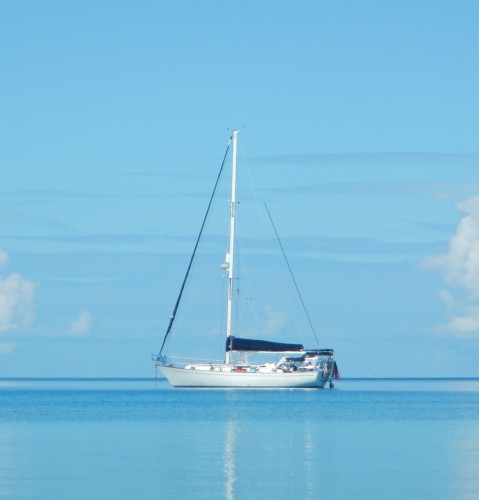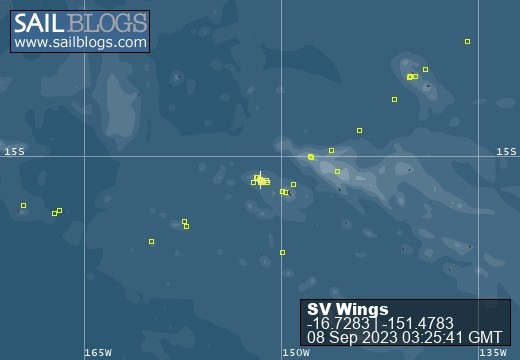
Voyages
These are the voyages of the sailing vessel, Wings.
19 September 2023 | Pension Tiare Nui
15 September 2023 | Pension Tiare Nui
13 September 2023 | Pension Tiare Nui
11 September 2023 | Pension Tiare Nui
07 September 2023 | Apooiti Bay
03 September 2023 | Tapuamu, Taha'a
02 September 2023 | Tapuamu, Taha'a
31 August 2023 | Haamene Bay, Taha'a
29 August 2023 | Relais Mehana Hotel, Huahine
26 August 2023 | Fare, Huahine
19 August 2023 | Aloe Cafe, Viatape
13 August 2023 | Aloe Cafe, Viatape
11 August 2023 | Apooiti Bay
11 August 2023 | Apooiti Bay mooring field
08 August 2023
08 August 2023 | Apooiti Bay, Raiatea
05 August 2023 | Raiatea Carenage
01 August 2023 | Raiatea Carenage
31 July 2023 | Raiatea Carenage
28 July 2023 | Orion Guest House
More Tasks Completed
05 August 2020 | Pension Tiare Nui
William Ennis | Still h-a-H
Blog 5 Aug 2020
More Tasks Completed
16 43.41'S:151 27.54'W
Again, I awakened us early and we were on the job by 0930...early for us, anyway.
I had some wiring goobers to repair. We're using, and I'm learning about, NMEA2000 networks, a powered network that's the standard these days. With all the features that they offer, both the cables and the connecting collars are fairly large. When pulling cable through small openings, I have been clipping the connecting collars and ends and installing a fitting with this mouthful of a name: field installable connector. The five small wires in each NMEA2000 (commonly abbreviated N2K) must be attached to a small device and a cable gland attached to make the entire fitting watertight. It's a great idea, the execution is good, but since the fitting is very small, getting those five wires to bend and fit into tiny locking terminals with only 3/16-inch of exposed wiring. It's simply tedious and sometimes frustrating, but not difficult. In my haste, I had mixed two wires and needed to open the fitting and change the connections. That was my second experience with the system.
Today, I installed the next-to-last piece of new equipment, a highly accurate GPS and electronic compass, without which many of the fancy features of our radar would not work. The GPS uses the US, Japanese, and Russian systems now in operation, so coverage is supposed to be extraordinary. Starts and stops, nothing exciting, but after a few hours I had the new "mushroom" (GPS antennae look like mushrooms and are so called) mounted. This task also required that I remove the male end of a N2K cable in order to push it through a small hole drilled in the hull, but it was my third try and it was a bit smoother.
Tomorrow, we'll connect all of the new electronics and determine if they all work as advertised. We know that the chart plotter and radar work. We know that our multifunction jack-of-all-trades device, the Triton, works, but we haven't tested the new GPS or depth transducer. We certainly haven't tried everything together, either.
As I have mentioned previously, our old autopilot still works well, but it uses a now-obsolete network called SeaTalk 1. I think that I have the parts that I need to try and connect that old system to our new network. The manufacturer of the old system, Raymarine, sold us a "translator" that is supposed to pass through and translate the "sentences" between each network to the other network. The autopilot will continue to work on the SeaTalk 1 network but this translator will allow appropriate data to be sent to the autopilot, as well as commands and location coordinates from our new chart plotter. The autopilot will operate by itself even without the communication with our new network, so even if this doesn't work, all is not lost. If I have the time tomorrow, I'll try to get that working, or at least give it a chance I've had to fabricate some cables, so we hope that it was done correctly.
Yesterday's brainstorm of using cardboard to wrap around the depth sounder fairing block and tracing the 3-D shape on the cardboard provided great results! I gave the fairing block with its cutting line marked in tape to the yard worker and he spent about 20 minutes cutting the block. It's as good a fit as we could have hoped, so I can begin the installation of that final new device.
The fairing block for the depth sounder is a 10-inch long block of plastic that could cause some steering problems should it spin and become perpendicular to our course. To prevent that, an "anti-rotation bolt" is installed in the forward section of the block. Of course, the hole for the old block doesn't align with the new one, so I've got to fill the old hole and drill a new one. The repair of the old hole, as I've said, must be a "tack" shape, with a large section of epoxy resin on the outside to prevent the thin cylinder of epoxy from being dislodged by pressure or some such. I was reading on-line about that repair and think that I might mange it if I can find the tools. We'll see tomorrow.
Lastly, we're planning on moving onto the boat on Friday, so blogs and such will definitely be reduced. We'll have no vehicle and will have intermittent access to Internet, to say nothing of cold showers and hotter sleeping! Living on the boat is the reason that we came here, but living on a boat in a boat yard is hot and dirty. We think that another week might allow us to complete everything and launch.
Wish us luck!
More Tasks Completed
16 43.41'S:151 27.54'W
Again, I awakened us early and we were on the job by 0930...early for us, anyway.
I had some wiring goobers to repair. We're using, and I'm learning about, NMEA2000 networks, a powered network that's the standard these days. With all the features that they offer, both the cables and the connecting collars are fairly large. When pulling cable through small openings, I have been clipping the connecting collars and ends and installing a fitting with this mouthful of a name: field installable connector. The five small wires in each NMEA2000 (commonly abbreviated N2K) must be attached to a small device and a cable gland attached to make the entire fitting watertight. It's a great idea, the execution is good, but since the fitting is very small, getting those five wires to bend and fit into tiny locking terminals with only 3/16-inch of exposed wiring. It's simply tedious and sometimes frustrating, but not difficult. In my haste, I had mixed two wires and needed to open the fitting and change the connections. That was my second experience with the system.
Today, I installed the next-to-last piece of new equipment, a highly accurate GPS and electronic compass, without which many of the fancy features of our radar would not work. The GPS uses the US, Japanese, and Russian systems now in operation, so coverage is supposed to be extraordinary. Starts and stops, nothing exciting, but after a few hours I had the new "mushroom" (GPS antennae look like mushrooms and are so called) mounted. This task also required that I remove the male end of a N2K cable in order to push it through a small hole drilled in the hull, but it was my third try and it was a bit smoother.
Tomorrow, we'll connect all of the new electronics and determine if they all work as advertised. We know that the chart plotter and radar work. We know that our multifunction jack-of-all-trades device, the Triton, works, but we haven't tested the new GPS or depth transducer. We certainly haven't tried everything together, either.
As I have mentioned previously, our old autopilot still works well, but it uses a now-obsolete network called SeaTalk 1. I think that I have the parts that I need to try and connect that old system to our new network. The manufacturer of the old system, Raymarine, sold us a "translator" that is supposed to pass through and translate the "sentences" between each network to the other network. The autopilot will continue to work on the SeaTalk 1 network but this translator will allow appropriate data to be sent to the autopilot, as well as commands and location coordinates from our new chart plotter. The autopilot will operate by itself even without the communication with our new network, so even if this doesn't work, all is not lost. If I have the time tomorrow, I'll try to get that working, or at least give it a chance I've had to fabricate some cables, so we hope that it was done correctly.
Yesterday's brainstorm of using cardboard to wrap around the depth sounder fairing block and tracing the 3-D shape on the cardboard provided great results! I gave the fairing block with its cutting line marked in tape to the yard worker and he spent about 20 minutes cutting the block. It's as good a fit as we could have hoped, so I can begin the installation of that final new device.
The fairing block for the depth sounder is a 10-inch long block of plastic that could cause some steering problems should it spin and become perpendicular to our course. To prevent that, an "anti-rotation bolt" is installed in the forward section of the block. Of course, the hole for the old block doesn't align with the new one, so I've got to fill the old hole and drill a new one. The repair of the old hole, as I've said, must be a "tack" shape, with a large section of epoxy resin on the outside to prevent the thin cylinder of epoxy from being dislodged by pressure or some such. I was reading on-line about that repair and think that I might mange it if I can find the tools. We'll see tomorrow.
Lastly, we're planning on moving onto the boat on Friday, so blogs and such will definitely be reduced. We'll have no vehicle and will have intermittent access to Internet, to say nothing of cold showers and hotter sleeping! Living on the boat is the reason that we came here, but living on a boat in a boat yard is hot and dirty. We think that another week might allow us to complete everything and launch.
Wish us luck!
Comments
| Vessel Name: | Wings |
| Vessel Make/Model: | Passport 40 |
| Hailing Port: | Anchorage, Alaska |
| Crew: | William Ennis and Constance Livsey |
| About: | We've been married since 1991, and both retired from our respective jobs (teacher and attorney) after long careers. We live in the most exotic of the United States: Alaska. We cruise on Wings for half the year, enjoying our home state the other part of the year. |
| Extra: | |
| Home Page: | http://svwings.com |
Wings's Photos - Main
No items in this gallery.
Who We Are

Who: William Ennis and Constance Livsey
Port: Anchorage, Alaska

